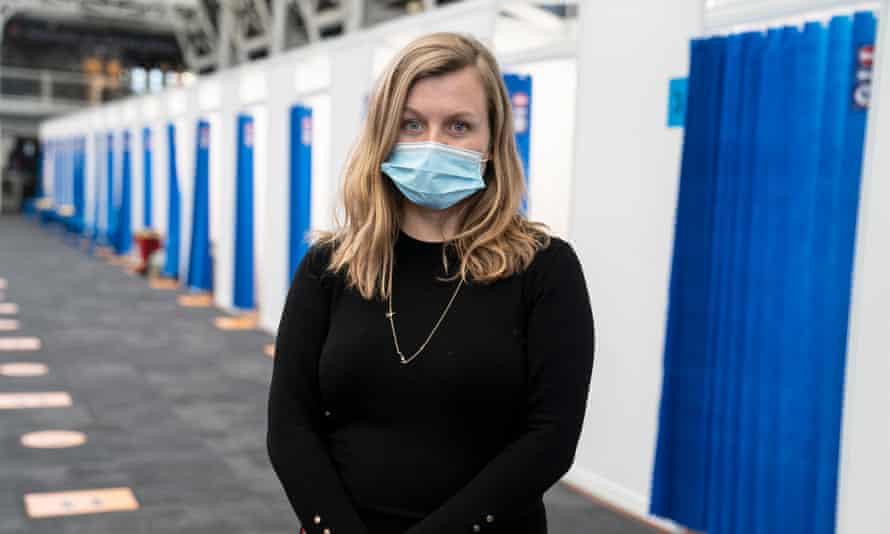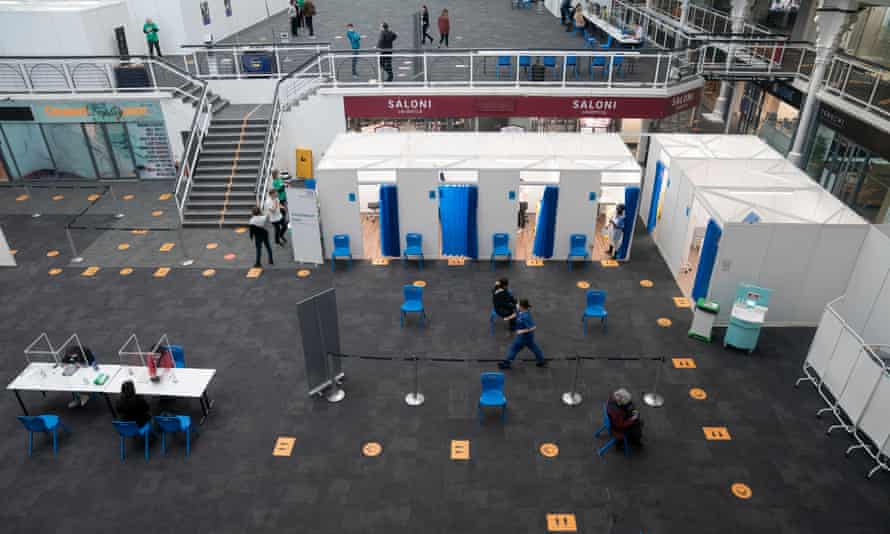“It’s been a big job putting this together”, says Laura Churchward with a sigh. She is referring to the weeks of intense planning, hard work and attention to detail that went into the opening – just minutes earlier – of the Business Design Centre in Islington as the NHS’s latest Covid mass vaccination centre.
The London exhibition centre usually hosts trade fairs. But on Wednesday the only visitors were 44 NHS staff, St John Ambulance personnel and volunteers and about 200 grateful recipients of the jab, some of whom had waited in the rain outside the venue.
It is now one of 134 mass vaccination centres (MVC) in England, 15 of which opened this week alone. They are a key part of the vast infrastructure the NHS has established since November to administer the Oxford/AstraZeneca and Pfizer/BioNTech vaccines to – so far – about 20 million people. The 1,660-strong network of sites also includes 268 “hospital hubs” for NHS and social care staff, 224 pharmacies and 1,034 GP-run sites, many of which are family doctor surgeries.
Churchward is already a veteran at helping to create MVCs. The Business Design Centre is her fifth. Her usual role is director of strategy at University College London Hospitals NHS trust. But when the pandemic struck she switched to setting up coronavirus testing centres and then to establishing premises to speed up the rollout of the vaccines. NHS England have put UCLH in charge of organising the vaccination programme to the 1.5 million people who live in the London boroughs of Camden, Islington, Haringey, Barnet and Enfield.

The new MVC delivered 200 jabs in the three and a half hours it opened on Wednesday. “But that will increase to 500 a day from next week, thanks to increased vaccine supply”, says Churchward. The deployment of the vaccines has been impressive so far, but it should move up another gear next week when the number of jabs delivered daily is planned to double from about 400,000 to 800,000 across England.
Vaccine supply has been across the five boroughs has been uncertain, she admits. “Last week it was touch and go whether or not we’d have enough vaccine to open up this site today, so we had to get 500 doses from the Francis Crick Institute”, the scientific research centre behind the British Library in central London, which is also doubling as an MVC. “We’ve had to move vaccine around the system on a weekly basis, to ensure each site has enough”, she adds.
Ultimately the light, glass and steel-roofed hall will be able to do 2,500-3,000 jabs daily. “These MVCs are there to jab big numbers of people – mega-numbers. They’re for the mainly healthy population, not the elderly and vulnerable who were done at first”, adds Churchward. The vaccinators on day one included Ed Wild, a professor of neurosurgery, as well as an ICU nurse and A&E staff, who all usually work at UCLH. “This is the NHS at its best”, says Churchward.
This is the second time the Business Design Centre has helped the country achieve a key goal since it opened in 1862 as the Royal Agricultural Hall. The bombing during the second world war of the Mount Pleasant post office half a mile away led to its inland and foreign parcels departments being rehoused at the hall.
There are now 421 floor stickers to guide arrivals around in a socially distanced way. It has 24 vaccination booths, 78 hand sanitiser stations, 55 computer stations and 202 blue plastic chairs for those waiting for their turn, going through check-in or giving their consent.

Diana Kootstra, UCLH’s construction programme manager, inspected the hall in December and judged it to be an ideal MVC because of its size, accessibility, good public transport links and excellent ventilation. Once she worked out how to ensure safe patient flow around it, UCLH reached a deal with its owners. A team of 17 architects, quantity surveyors, engineers, data analysts and a construction team all played their part over the last ten weeks
It was originally due to open on 22 February. That had to be delayed, though, because of uncertainty over both whether there would be enough vaccine available and also whether enough people would be eligible to come, which itself depended on how quickly the nine different priority groups for vaccination, as decided by the Joint Committee on Vaccination and Immunisation, were opened up. That has now reached group eight, those aged 55 and over.
Ivan Clark, a 62-year-old data analyst, was one of the first to get jabbed at the repurposed venue. Consent has to be taken by a doctor or nurse, so he gave his to a UCLH nurse. But he received his jab in his left arm from Neal Pun, a second-year medical student at University College London. While some of the vaccinators are NHS staff, many are volunteers who have been trained.
“It was seamless. I only had to wait for five minutes. All the marshals showed me where to go”, said Clark, who wore his West Ham facemask throughout. “I was utterly gobsmacked that we beat the 15.2m target before the 15 February deadline that Boris Johnson set. I analyse all the government data every day and the vaccination rollout is a success story – it’s incredible. I can’t say the same about the rest of the government’s response to Covid, though.”
This content first appear on the guardian
